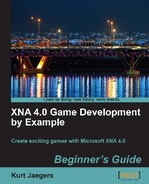- Double-click on the
Game1.csfile in the Level Editor project to open it in the editor. - Add the following declarations to the Game1 declarations area:
public int DrawLayer = 0; public int DrawTile = 0; public bool EditingCode = false; public string CurrentCodeValue = ""; public string HoverCodeValue = ""; public MouseState lastMouseState; System.Windows.Forms.VScrollBar vscroll; System.Windows.Forms.HScrollBar hscroll;
- Add the following lines to the Game1 constructor:
vscroll = (System.Windows.Forms.VScrollBar)parentForm.Controls[ "vScrollBar1"]; hscroll = (System.Windows.FOrms.HScrolLBar)parentForm.Controls[ "hScrollBar1"];
- Modify the
LoadContent()method of the Game1 class to read:protected override void LoadContent() { spriteBatch = new SpriteBatch(GraphicsDevice); Camera.ViewPortWidth = pictureBox.Width; Camera.ViewPortHeight = pictureBox.Height; Camera.WorldRectangle = new Rectangle( 0, 0, TileMap.TileWidth * TileMap.MapWidth, TileMap.TileHeight * TileMap.MapHeight ); TileMap.Initialize( Content.Load<Texture2D>(@"TexturesPlatformTiles")); TileMap.spriteFont = Content.Load<SpriteFont>(@"FontsPericles8"); lastMouseState = Mouse.GetState(); pictureBox_SizeChanged(null, null); } - Modify the
Draw()method of the Game1 class to read:protected override void Draw(GameTime gameTime) { GraphicsDevice.Clear(Color.Black); spriteBatch.Begin( SpriteSortMode.BackToFront, BlendState.AlphaBlend); TileMap.Draw(spriteBatch); spriteBatch.End(); base.Draw(gameTime); }
To simplify communications between the Windows Form and the XNA Game, we have declared a number of public member variables that our Windows Form code will be able to update in response to user-generated events. We have also loaded a SpriteFont to draw code values with, and a MouseState variable to hold the state of the mouse between frames.
Finally, we declare two objects that reference the scroll bars on the level editor form. We will use these to sync up the display of the tile map to the location of the scroll bars.
The LoadContent() method is fairly standard, setting the size of the tile map, and loading the tile images and sprite font. The TileMap class's spriteFont member is set to the font we loaded, and the lastMouseState member is initialized. Right before exiting, the LoadContent() method calls pictureBox_SizeChanged() to make sure that the graphics device has the proper dimensions for the display window.
In our Draw() method, we have again used the expanded form of the SpriteBatch.Begin() call in order to specify the SpriteSortMode.BackToFront parameter.
